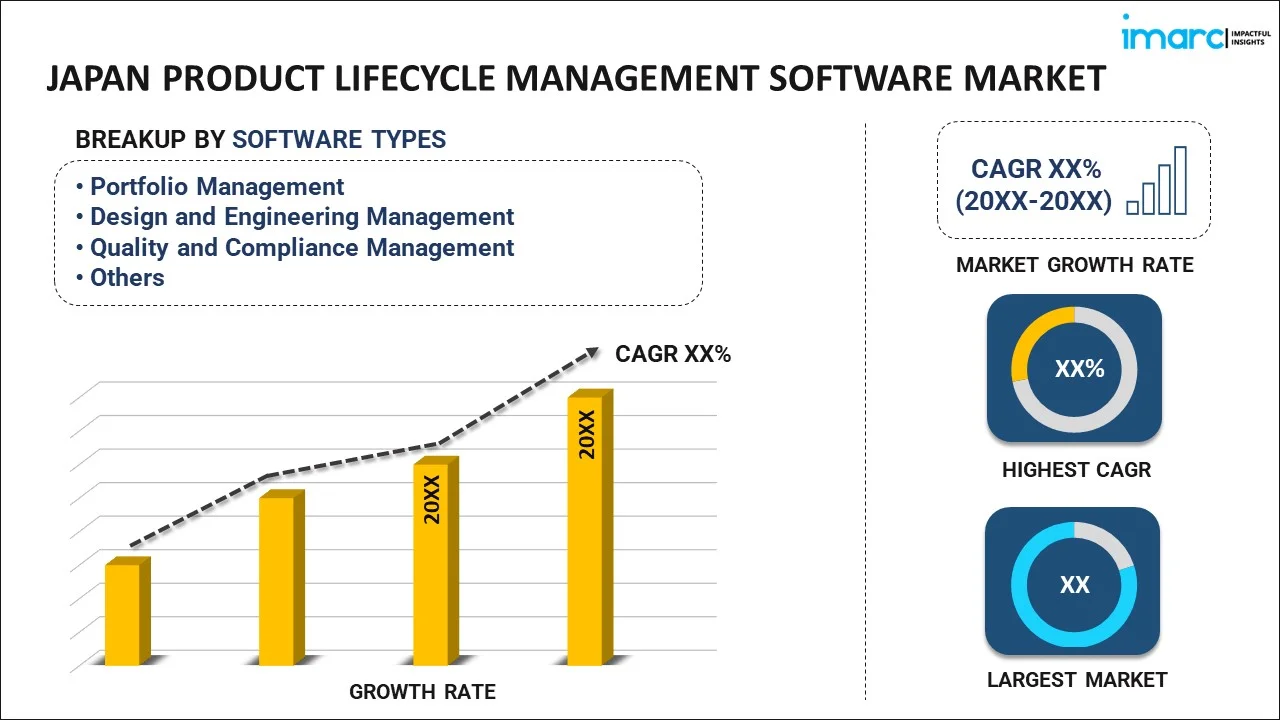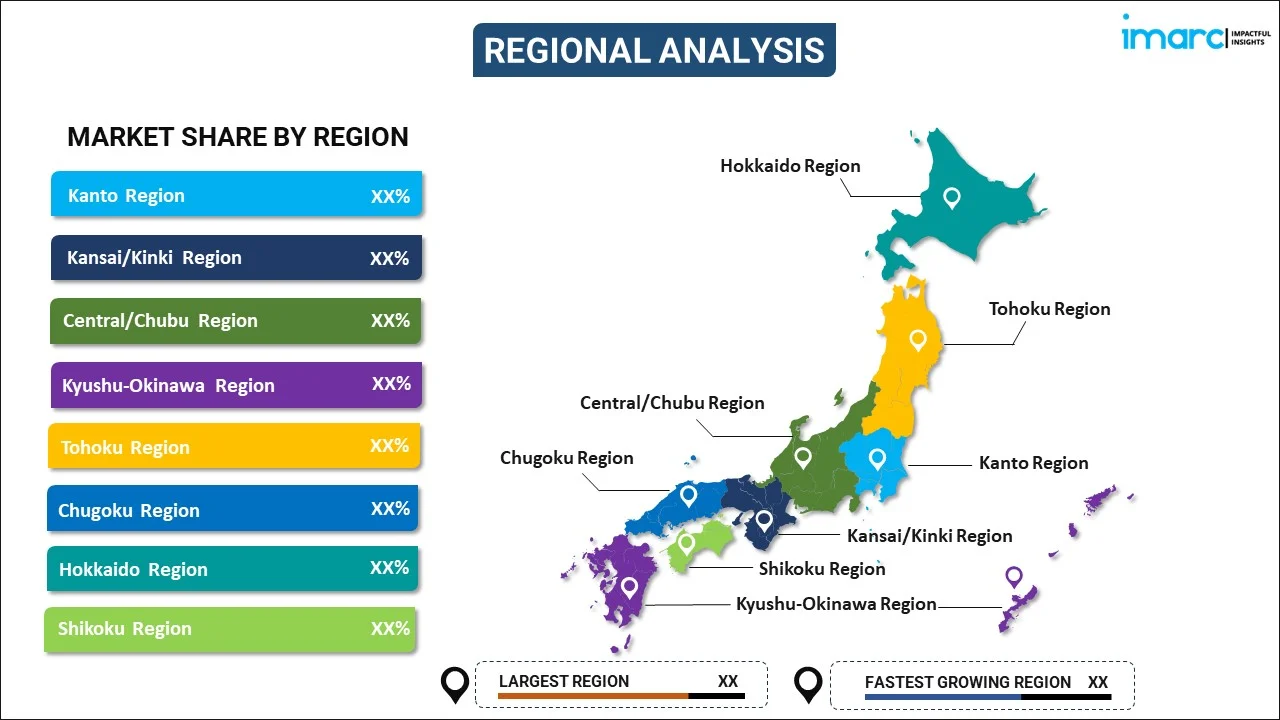
Japan Product Lifecycle Management Software Market Report by Software Type (Portfolio Management, Design and Engineering Management, Quality and Compliance Management, Simulation, Testing and Change Management, Manufacturing Operations Management, and Others), Deployment Type (On-premises, Cloud-based), End User (Aerospace and Defense, Automotive and Transportation, Healthcare, IT and Telecom, Industrial Equipment and Heavy Machinery, Retail, Semiconductor and Electronics, and Others), and Region 2025-2033
Market Overview:
Japan product lifecycle management software market size reached USD 1.4 Billion in 2024. Looking forward, IMARC Group expects the market to reach USD 2.6 Billion by 2033, exhibiting a growth rate (CAGR) of 6.7% during 2025-2033. The increasing incorporation of data analytics and artificial intelligence in product lifecycle management software to provide insights into product performance, predict maintenance needs, and optimize designs is driving the market.
|
Report Attribute
|
Key Statistics
|
|---|---|
|
Base Year
|
2024 |
|
Forecast Years
|
2025-2033
|
|
Historical Years
|
2019-2024
|
| Market Size in 2024 | USD 1.4 Billion |
| Market Forecast in 2033 | USD 2.6 Billion |
| Market Growth Rate (2025-2033) | 6.7% |
Product lifecycle management (PLM) software is a comprehensive digital toolset designed to manage every aspect of a product's lifecycle, from concept and design through manufacturing, distribution, and eventual retirement. It serves as a centralized repository for all product-related data, enabling efficient collaboration among teams and stakeholders. PLM software helps streamline processes, reduce errors, and accelerate time-to-market by facilitating the sharing of product information, design changes, and revisions in real time. It enables companies to track and manage product development milestones, monitor costs, and ensure compliance with regulatory requirements. Key features of PLM software include version control, document management, CAD integration, workflow automation, and analytics. It benefits various industries, including manufacturing, aerospace, automotive, and consumer goods. By optimizing product development and management processes, PLM software enhances innovation, reduces costs, and ultimately boosts competitiveness in today's fast-paced and complex markets. It provides a holistic view of a product's entire lifecycle, helping companies make informed decisions to maximize their products' success.
Japan Product Lifecycle Management Software Market Trends:
The product lifecycle management software market in Japan is multifaceted, with several key factors propelling its growth. To begin with, the relentless pace of technological innovation continually fuels the demand for PLM solutions. As businesses strive to stay competitive, they increasingly rely on advanced software to streamline product development processes. Furthermore, the rising complexity of products across various industries necessitates robust PLM solutions. These tools facilitate efficient collaboration among cross-functional teams, fostering innovation and reducing time-to-market. Moreover, regulatory compliance is an ever-present concern, prompting companies to invest in PLM software for accurate data management and traceability. Apart from this, the growing emphasis on sustainability drives the adoption of PLM systems as they enable companies to assess the environmental impact of their products and implement eco-friendly design changes. Lastly, the emerging digitalization of businesses that is enhancing the adoption of PLM software, since it enables companies to digitize their product data, making it accessible and actionable across the organization, is expected to drive the product lifecycle management software market in Japan during the forecast period.
Japan Product Lifecycle Management Software Market Segmentation:
IMARC Group provides an analysis of the key trends in each segment of the market, along with forecasts at the country level for 2025-2033. Our report has categorized the market based on software type, deployment type, and end user.
Software Type Insights:

- Portfolio Management
- Design and Engineering Management
- Quality and Compliance Management
- Simulation, Testing and Change Management
- Manufacturing Operations Management
- Others
The report has provided a detailed breakup and analysis of the market based on the software type. This includes portfolio management, design and engineering management, quality and compliance management, simulation, testing and change management, manufacturing operations management, and others.
Deployment Type Insights:
- On-premises
- Cloud-based
A detailed breakup and analysis of the market based on the deployment type have also been provided in the report. This includes on-premises and cloud-based.
End User Insights:
- Aerospace and Defense
- Automotive and Transportation
- Healthcare
- IT and Telecom
- Industrial Equipment and Heavy Machinery
- Retail
- Semiconductor and Electronics
- Others
The report has provided a detailed breakup and analysis of the market based on the end user. This includes aerospace and defense, automotive and transportation, healthcare, IT and telecom, industrial equipment and heavy machinery, retail, semiconductor and electronics, and others.
Regional Insights:

- Kanto Region
- Kansai/Kinki Region
- Central/ Chubu Region
- Kyushu-Okinawa Region
- Tohoku Region
- Chugoku Region
- Hokkaido Region
- Shikoku Region
The report has also provided a comprehensive analysis of all the major regional markets, which include Kanto Region, Kansai/Kinki Region, Central/ Chubu Region, Kyushu-Okinawa Region, Tohoku Region, Chugoku Region, Hokkaido Region, and Shikoku Region.
Competitive Landscape:
The market research report has also provided a comprehensive analysis of the competitive landscape. Competitive analysis such as market structure, key player positioning, top winning strategies, competitive dashboard, and company evaluation quadrant has been covered in the report. Also, detailed profiles of all major companies have been provided.
Japan Product Lifecycle Management Software Market Report Coverage:
| Report Features | Details |
|---|---|
| Base Year of the Analysis | 2024 |
| Historical Period | 2019-2024 |
| Forecast Period | 2025-2033 |
| Units | Billion USD |
| Scope of the Report | Exploration of Historical Trends and Market Outlook, Industry Catalysts and Challenges, Segment-Wise Historical and Future Market Assessment:
|
| Software Types Covered | Portfolio Management, Design and Engineering Management, Quality and Compliance Management, Simulation, Testing and Change Management, Manufacturing Operations Management, Others |
| Deployment Types Covered | On-premises, Cloud-based |
| End Users Covered | Aerospace and Defense, Automotive and Transportation, Healthcare, IT and Telecom, Industrial Equipment and Heavy Machinery, Retail, Semiconductor and Electronics, Others |
| Regions Covered | Kanto Region, Kansai/Kinki Region, Central/ Chubu Region, Kyushu-Okinawa Region, Tohoku Region, Chugoku Region, Hokkaido Region, Shikoku Region |
| Customization Scope | 10% Free Customization |
| Post-Sale Analyst Support | 10-12 Weeks |
| Delivery Format | PDF and Excel through Email (We can also provide the editable version of the report in PPT/Word format on special request) |
Key Questions Answered in This Report:
- How has the Japan product lifecycle management software market performed so far and how will it perform in the coming years?
- What has been the impact of COVID-19 on the Japan product lifecycle management software market?
- What is the breakup of the Japan product lifecycle management software market on the basis of software type?
- What is the breakup of the Japan product lifecycle management software market on the basis of deployment type?
- What is the breakup of the Japan product lifecycle management software market on the basis of end user?
- What are the various stages in the value chain of the Japan product lifecycle management software market?
- What are the key driving factors and challenges in the Japan product lifecycle management software?
- What is the structure of the Japan product lifecycle management software market and who are the key players?
- What is the degree of competition in the Japan product lifecycle management software market?
Key Benefits for Stakeholders:
- IMARC’s industry report offers a comprehensive quantitative analysis of various market segments, historical and current market trends, market forecasts, and dynamics of the Japan product lifecycle management software market from 2019-2033.
- The research report provides the latest information on the market drivers, challenges, and opportunities in the Japan product lifecycle management software market.
- Porter's five forces analysis assist stakeholders in assessing the impact of new entrants, competitive rivalry, supplier power, buyer power, and the threat of substitution. It helps stakeholders to analyze the level of competition within the Japan product lifecycle management software industry and its attractiveness.
- Competitive landscape allows stakeholders to understand their competitive environment and provides an insight into the current positions of key players in the market.
Need more help?
- Speak to our experienced analysts for insights on the current market scenarios.
- Include additional segments and countries to customize the report as per your requirement.
- Gain an unparalleled competitive advantage in your domain by understanding how to utilize the report and positively impacting your operations and revenue.
- For further assistance, please connect with our analysts.
 Inquire Before Buying
Inquire Before Buying
 Speak to an Analyst
Speak to an Analyst
 Request Brochure
Request Brochure
 Request Customization
Request Customization




.webp)




.webp)












